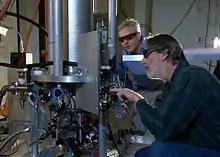NIST-F2
NIST-F2 is a caesium fountain atomic clock that, along with NIST-F1, serves as the United States' primary time and frequency standard.[1] NIST-F2 was brought online on 3 April 2014.[1][2]

Accuracy
NIST-F1, a caesium fountain atomic clock used since 1999, has a fractional inaccuracy (δf / f) of less than 5×10−16.
The planned performance of NIST-F2 is δf / f < 1×10−16.[3] At this planned performance level the NIST-F2 clock will not lose a second in at least 300 million years.[4]
Evaluated accuracy
The evaluated accuracy (uB) reports of various primary frequency and time standards are published online by the International Bureau of Weights and Measures (BIPM). The first in-house accuracy evaluation of NIST-F2 reported a uB of 1.1 × 10−16.[5] In March 2014 and March 2015 the NIST-F2 caesium fountain clock reported a uB of 1.5 × 10−16 in the BIPM reports of evaluation of primary frequency standards.
However, the uncertainty evaluation of NIST-F2's frequency shift due to distributed cavity phase,[2] which currently limits many other accurate atomic fountain clocks, had a shortcoming that makes it difficult to assign an accuracy until this error is re-evaluated.[6] In addition, the largest systematic error of NIST-F2 is a microwave amplitude dependent frequency shift,[2] which includes frequency shifts due to the microwave lensing of atomic wave-packets by microwave dipole forces on the atoms[7] and microwave leakage. An independent statistical analysis[8] of the NIST measurements[2] showed that this uncertainty was significantly too small and should be increased from 0.8 × 10−16 to at least 1.5 × 10−16.[6] As a result, the quoted uncertainty of NIST-F2 would increase to approximately 1.7 × 10−16, if the re-evaluation of the uncertainty due to distributed cavity phase shows that it is small. The March, 2015 report to the BIPM did not address the published criticism and there have been neither subsequent reports to the BIPM nor has an updated accuracy evaluation been published. The last submission of NIST-F1 to BIPM TAI was February 2016.[9]
At the request of the Italian standards organization, NIST fabricated many duplicate components for a second version of NIST-F2, known as IT-CsF2 to be operated by the Istituto Nazionale di Ricerca Metrologica (INRiM), NIST's counterpart in Turin, Italy.[1] As of February 2016 the IT-CsF2 caesium fountain clock started reporting a uB of 1.7 × 10−16 in the BIPM reports of evaluation of primary frequency standards.[10][11]
References
- NIST Launches a New U.S. Time Standard: NIST-F2 Atomic Clock
- First Accuracy Evaluation of NIST-F2, T. P. Heavner, S. R. Jefferts, J. H. Shirley, T. E. Parker, E. A. Donley, N. Ashby, S. Barlow, F. Levi, and G. Costanzo, May 2014
- Jefferts, Steven R.; Heavner, Thomas P.; Parker, Thomas E.; Shirley, Jon H. (September 2007). NIST Cesium Fountains — Current Status and Future Prospects (PDF). International School and Conference on Optics and Optical Materials, ISCOM07. Acta Physica Polonica A. 112 (5). Belgrade, Serbia. pp. 759–767. doi:10.1117/12.734965. Also available from NIST directly.
- "Time gets an upgrade". New Scientist. 12 April 2014. p. 7.
- Heavner T P, Donley E A , Levi F, Costanzo G, Parker TE, Shirley J H, Ashby N, Barlow S and Jefferts SR, “First accuracy evaluation of NIST-F2,” 2014 Metrologia 51, 174–182, May 2014
- Comment on 'First accuracy evaluation of NIST-F2,' Kurt Gibble, Metrologia 52, 163, January 2015
- Improved accuracy of the NPL-CsF2 primary frequency standard: evaluation of distributed cavity phase and microwave lensing frequency shifts, Ruoxin Li, Kurt Gibble, and Krzysztof Szymaniec, August 2011
- Gibble, Kurt (2015-06-18). "Reply to Comment on 'Ramsey spectroscopy, matter-wave interferometry, and the microwave-lensing frequency shift' ". Physical Review A. 91 (6): 067602. Bibcode:2015PhRvA..91f7602G. doi:10.1103/PhysRevA.91.067602.
- "BIPM - Time Department FTP server". www.bipm.org. Retrieved 2019-03-22.
- February 2016 IT-CsF2 TAI evaluation
- June 2018 IT-CsF2 TAI evaluation
External links
- NIST Time and Frequency Div. — 2004: Strategic Focus 1 (National Institute of Standards and Technology)
- "NIST Launches a New U.S. Time Standard: NIST-F2 Atomic Clock" on YouTube
- "Time gets an upgrade". newscientist.com. New Scientist. Retrieved 27 February 2018.